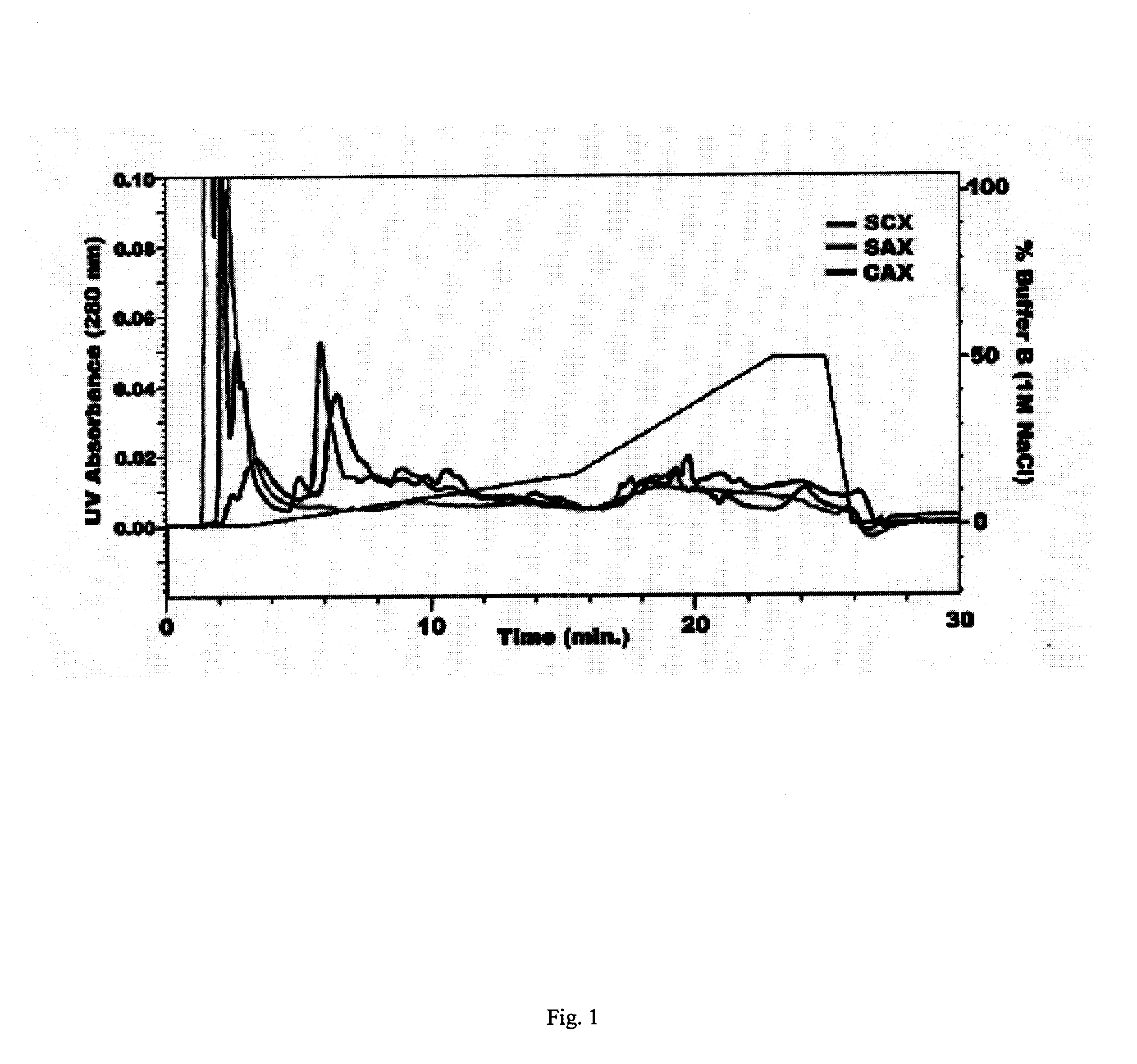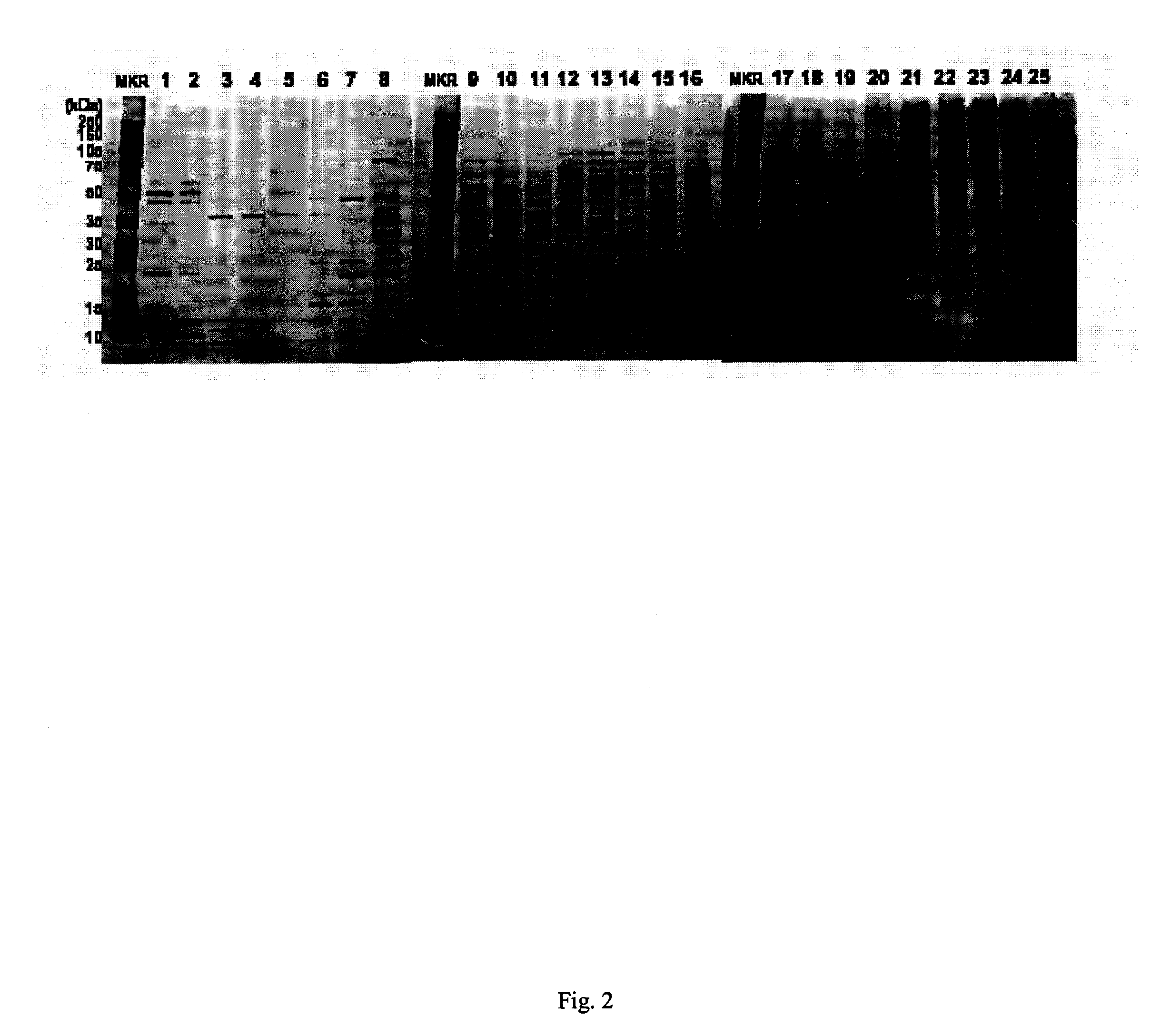Multidimensional protein separation
a protein and multi-dimensional technology, applied in the field of proteomics, can solve the problems of many challenges that still persist, and achieve the effects of easy visualization, increased resolving power, and high protein separation
- Summary
- Abstract
- Description
- Claims
- Application Information
AI Technical Summary
Benefits of technology
Problems solved by technology
Method used
Image
Examples
example 1
CAX Chromatography—First Dimension
[0118] The majority of proteins in biological samples such as tissue lysates or body fluids retain regions of significant charge on their external surfaces when at physiological pH. Considered together, the net charge of these external regions approximately half of the time is negative and somewhat less than half of the time is net positive. Though in reality regions of external charge act independent of net charge, a general explanation for performing combined SCX and SAX is that categorically CAX will retain positively and negatively charged proteins rather than predominantly those of one net polarity. FIG. 1 illustrates the difference in gradient separation of a complex brain tissue lysate with independent SCX, SAX, and CAX chromatography. The single ion exchangers allow a significant portion of the proteome to flow through unretained, as evidenced by the large peak at the beginning of the chromatograms. CAX binds most proteins by charge interac...
example 2
Coupling to 1D-PAGE—Second Dimension
[0120] Orthogonal to ionic-strength, protein mass is used in the second dimension with 1D-PAGE to further resolve the complex brain lysate. A fraction volume of 1 mL, practical with the CAX flowrate and the BioFrac fraction collector, generally encompassed elution of entire proteins with CAX half-height peak widths generally in the order of 0.25 mL. A foreseen difficulty of CAX common with other fractionation strategies is that proteins can break across two fractions, fortunately this statistically is less likely at lower concentration when otherwise the problem would be most dramatic. Another complication is that the fraction volume is large relative to the loading volume of a gel. Microtube centrifugal filters were used to concentrate fractions to a manageable volume. A mass cutoff of 30 kDa was selected based on its association with relative pore size and not mass. Proteins>5 kDa are routinely retained with this filter, while the larger pore s...
example 3
CAX-PAGE Protein Recovery and Retention
[0125] Ion-exchange chromatography has a high loading capacity, making it advantageous as a first dimensional separation. Capacity affords the ability to load a significant amount of protein permitting reasonable sample loss common in multi step processes. Of concern when combining SAX and SCX phases was the possibility of exacerbated protein loss. Protein assay results suggested an increase in protein recovery with CAX at 67% of total protein compared with 49% for separate SAX and 59% for SCX. All assays performed were normalized using a fixed volume of the initial sample; however, fraction composition would differ between separations thereby effecting relative quantitation between ion-exchange modes. In contrast, peak area analysis indicated greater recovery from SCX at an area of 15.5 than for CAX at 12.8 and SAX at 9.25. Both methods suggested SAX may irreversibly trap more than SCX, but no additional sample loss is observed with CAX chrom...
PUM
| Property | Measurement | Unit |
|---|---|---|
| Length | aaaaa | aaaaa |
| Fraction | aaaaa | aaaaa |
| Fraction | aaaaa | aaaaa |
Abstract
Description
Claims
Application Information
 Login to View More
Login to View More - R&D
- Intellectual Property
- Life Sciences
- Materials
- Tech Scout
- Unparalleled Data Quality
- Higher Quality Content
- 60% Fewer Hallucinations
Browse by: Latest US Patents, China's latest patents, Technical Efficacy Thesaurus, Application Domain, Technology Topic, Popular Technical Reports.
© 2025 PatSnap. All rights reserved.Legal|Privacy policy|Modern Slavery Act Transparency Statement|Sitemap|About US| Contact US: help@patsnap.com



